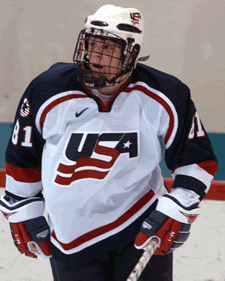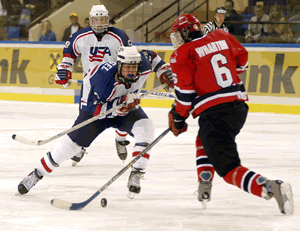July
6, 2004
The
Next One
He’s just 16, but Kessel could be college
hockey’s superstar in waiting
By
Nate Ewell
 |
| Boston
University, Michigan, Minnesota and Wisconsin are among those
contending to land top prospect Phil Kessel of the U.S. NTDP. |
High school
basketball players make the cover of Sports Illustrated
on an annual basis. Teenage golf phenom Michelle Wie competes
in professional tournaments, against both men and women. Freddy
Adu joined Major League Soccer full-time this spring. Stop by
a hockey equipment shop and you can buy a stick pattern designed
for 16-year-old Sidney Crosby.
In the fast-food
world of sports today, it’s not just what’s available
now. We’re identifying future menu items years in advance.
College hockey’s
no different. If you haven’t heard his name yet, listen
up: 16-year-old Phil Kessel is coming to a campus rink near you
in the not-too-distant future.
Kessel wowed
scouts during Team USA’s silver-medal performance at the
2004 Under-18 World Championship. The youngest member of the American
team, Kessel led the tournament in goals with seven in six games,
and finished one point shy (10) of the tourney scoring lead. He
broke the U.S. National Team Development Program goal-scoring
record last season, which was previously held by Nashville Predator
and former Michigan State Spartan Adam Hall. This summer he’ll
skate with players nearly three years his senior at the U.S. National
Junior Team Evaluation Camp.
“He’s
a natural born goal scorer,” said John Hynes, the former
Wisconsin assistant coach who now leads the NTDP and coached Kessel
at the Under-18 tournament. “Phil has the ability, kind
of like Brett Hull, with a natural quick release where the puck
just seems to find the net. He’s extremely fast, and his
skating is exceptional.”
 |
| Kessel
led all players in the Under-18 World Championship with seven
goals in six games. John Hynes, who coached him in that tournament,
compares him to Mike Modano or Brett Hull. |
That talent
level has college recruiters salivating, a full year before NCAA
rules allow them to contact Kessel directly. Major junior officials,
meanwhile, hope Kessel eschews college and follows the route of
Crosby, who is currently in the QMJHL.
That, according
to the forward from Madison, Wisc., isn’t going to happen.
“I’m
going to go to college,” Kessel declares confidently. “All
colleges are amazing; I’ve just got to decide which one
is right for me.”
Kessel isn’t
narrowing his choices at this point, at least not publicly. Sources
indicate that Boston University, Michigan, Minnesota and Wisconsin
are the leading candidates, in no particular order.
At 5-foot-10
and 160 pounds, Kessel is a dynamic player with offensive flair.
While small now, he still has room to grow – remember, he
won’t be 17 until Oct. 2. Kessel cites Peter Forsberg and
Joe Sakic as his favorite players; scouts compare his combination
of skating and scoring ability to another American, Mike Modano.
“He’s
an up-tempo, high-energy type of player,” Hynes said. “He
could have the ability of a Forsberg, but he doesn’t have
that much grit to his game yet. He’s more of an up-and-down
type of guy, like Modano.”
What’s
most remarkable, Hynes said, is that Kessel’s game still
has room for growth.
“To
this point, he’s done what his ability says he’s capable
of,” Hynes said. “But for him to play a more complete
game, and to be able to make the rest of his teammates better,
he still has room to grow.”
| Five
More Next Ones |
| Needless
to say, Kessel isn't the only 1987 birthdate generating
excitement among college scouts. Here are five others to
keep an eye on:
Andrew
Cogliano: The hand-wringing has begun in Canada over this
OPJHL star's decision to play college hockey instead of
major junior. He's committed to Michigan.
Jeff
Frazee: The quick, acrobatic NTDP goaltender has committed
to Minnesota.
Nathan
Gerbe: At 5-foot-5 with talent and grit, the Brian Gionta
comparisons were inevitable, even before he committed to
Boston College.
Zach
Jones: Terrific defensively, he was the top U.S. defenseman
at the Under-18 World Championship as a 16 year old. Uncommitted.
Jack
Skille: The Wisconsin commitment may not have the flash
of a Kessel or Gerbe, but he's a prototypical power forward.
|
Kessel has
a laid-back, happy-go-lucky approach to life that you’d
expect from a 16-year-old. But he takes his hockey seriously,
and he is confident in his choice of college hockey over major
juniors.
“It
was a pretty easy decision,” he said. “I’ve
grown up watching college hockey, and I really like the atmosphere
of the college game. Getting to play in front of those kinds of
crowds would be amazing.”
The next choice
– where to go – will depend on a number of factors.
He favors a school that plays an up-tempo, offensive style and
features a classic college hockey atmosphere. Location won’t
be a deciding factor, as he shrugs off suggestions that Wisconsin
might have an edge since he’s from Madison.
While Kessel
may be set on attending college, the major junior option remains
– something that the OHL’s Saginaw Spirit, which owns
his rights, will likely remind him of regularly until he gets
to campus. The Spirit’s new general manager is former college
hockey player and coach Bob Mancini, and he’s well aware
of the impact Kessel could have in his lineup.
“He’s
a dynamic player with NHL potential, who from our point of view
should be playing in the Ontario Hockey League,” said Mancini,
who will make another push for Kessel's services this month. “There’s
nothing more important than what the family thinks is right for
Phil Kessel. We respect that, and we think we are a great option
for him and his family to consider. He knows that we would love
for him to come play in Saginaw.”
Meanwhile,
Kessel prepares for a second season with the U.S. NTDP in Ann
Arbor, an experience he calls “one of the best opportunities
of my life.” He’s also trying to accelerate his high
school studies, an option that would allow him to enter college
in the fall of 2005, as a 17-year-old.
Finishing
high school in three years is increasingly popular among blue-chip
recruits, potentially speeding up the development process and
giving them an extra year of high-level hockey before they are
eligible for the NHL Entry Draft.
It may also
mean one less year for us to wait before the consensus “next
superstar” is playing in college hockey.